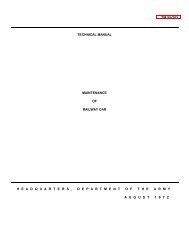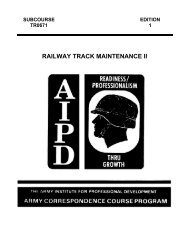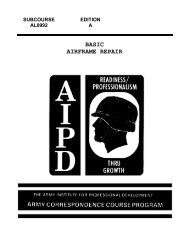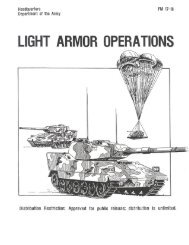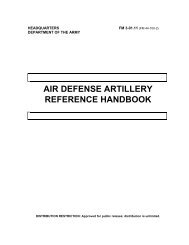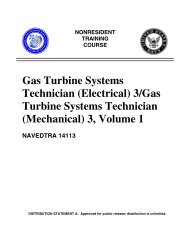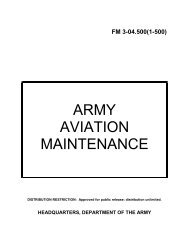fm 44-100 us army air and missile defense operations
fm 44-100 us army air and missile defense operations
fm 44-100 us army air and missile defense operations
You also want an ePaper? Increase the reach of your titles
YUMPU automatically turns print PDFs into web optimized ePapers that Google loves.
FM <strong>44</strong>-<strong>100</strong><br />
AIR DEFENSE IN FORCE PROTECTION<br />
1-18. Comm<strong>and</strong>ers seek to apply overwhelming combat power to achieve<br />
victory with minimum casualties to their forces <strong>and</strong> assets. Combat power<br />
combines the elements of maneuver, firepower, protection, <strong>and</strong> leadership.<br />
Overwhelming combat power is the ability to foc<strong>us</strong> sufficient force to ensure<br />
success <strong>and</strong> deny the enemy any chance of escape or effective retaliation.<br />
Comm<strong>and</strong>ers apply overwhelming combat power by bringing all combat<br />
elements to bear at the optimum time <strong>and</strong> place, giving the enemy no<br />
opportunity to respond effectively. Comm<strong>and</strong>ers integrate <strong>and</strong> coordinate a<br />
variety of functions with the elements of combat power. As a result, they<br />
convert the potential of forces, resources, <strong>and</strong> opportunities into actual<br />
capability through violent, coordinated action at the decisive time <strong>and</strong> place.<br />
They attempt to defeat the enemy's combat power by interfering with its<br />
ability to conduct reconnaissance, maneuver, <strong>and</strong> apply firepower.<br />
1-4<br />
1-19. While contributing to all four elements of combat power, ADA makes its<br />
greatest contribution to force protection. Protection conserves the fighting<br />
potential of a force so that comm<strong>and</strong>ers can apply it at the decisive time <strong>and</strong><br />
place. It includes active <strong>and</strong> passive actions units take to preserve combat<br />
power <strong>and</strong> deny the enemy the ability to successfully attack the force. Force<br />
protection has five components:<br />
• Air <strong>and</strong> <strong>missile</strong> <strong>defense</strong> <strong>operations</strong><br />
• OPSEC/deception <strong>operations</strong><br />
• Health/morale of soldiers<br />
• Safety<br />
• Avoidance of fratricide<br />
1-20. The first component of force protection is <strong>air</strong> <strong>and</strong> <strong>missile</strong> <strong>defense</strong><br />
<strong>operations</strong>. Offensive counter<strong>air</strong> <strong>and</strong> Theater Missile Defense (TMD) attack<br />
<strong>operations</strong> attempt to defeat or suppress enemy capabilities to launch <strong>air</strong> <strong>and</strong><br />
<strong>missile</strong> attacks. Defensive counter<strong>air</strong> <strong>and</strong> TMD active <strong>defense</strong> destroy enemy<br />
<strong>air</strong>craft <strong>and</strong> <strong>missile</strong>s that threaten the force.<br />
1-21. The second component of protection combines <strong>operations</strong> security<br />
(OPSEC) <strong>and</strong> deception <strong>operations</strong>, to help keep the enemy from locating<br />
friendly units. Proper dispersion helps reduce losses from enemy fires, as<br />
does the <strong>us</strong>e of camouflage, discipline, counter-reconnaissance, security<br />
<strong>operations</strong>, <strong>and</strong> fortified fighting positions. Air <strong>defense</strong> contributes to<br />
counter-reconnaissance by destroying UAVs <strong>and</strong> <strong>air</strong>craft conducting<br />
reconnaissance, surveillance, <strong>and</strong> target acquisition (RSTA) <strong>operations</strong><br />
against the force. Frequent moves disrupt the enemy RSTA cycle. These<br />
measures help comm<strong>and</strong>ers protect their force from enemy observation<br />
throughout the conduct of <strong>operations</strong>.<br />
1-22. The health <strong>and</strong> welfare aspect of force protection keeps soldiers healthy<br />
<strong>and</strong> maintains fighting morale. Comm<strong>and</strong>ers <strong>and</strong> leaders at all levels take<br />
care of their soldiers' basic health needs. They consider the welfare <strong>and</strong> spirit<br />
of soldiers as they build cohesion <strong>and</strong> unit esprit de corps.<br />
1-23. Safety is the fourth component of protection <strong>and</strong> is a part of all<br />
<strong>operations</strong>. Comm<strong>and</strong>ers <strong>and</strong> leaders embrace safety as a principal element




